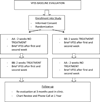Effects of the Mendelsohn maneuver on extent of hyoid movement and UES opening post-stroke
- PMID: 23494471
- PMCID: PMC3718861
- DOI: 10.1007/s00455-013-9461-1
Effects of the Mendelsohn maneuver on extent of hyoid movement and UES opening post-stroke
Abstract
The Mendelsohn maneuver, voluntary prolongation of laryngeal elevation during the swallow, has been widely used as a compensatory strategy to improve upper esophageal sphincter (UES) opening and bolus flow. Recent research suggests that when used as a rehabilitative exercise, it significantly improves duration of hyoid movement and positively impacts duration of UES opening (DOUESO). The data presented here were derived from that same prospective crossover study of 18 participants with dysphagia post-stroke evaluated with videofluoroscopy after treatment using the Mendelsohn maneuver versus no treatment. Results demonstrate gains in the extent of hyoid movement and UES opening and improvements in coordination of structural movements with each other as well as with bolus flow.
Conflict of interest statement
The authors declare they have no conflict of interest.
Figures
References
-
- Mendelsohn MS, McConnell FM. Function in the pharyngoesophageal segment. Laryngoscope. 1987;97(4):483–489. - PubMed
-
- Dodds WJ, Stewart ET, Logemann JA. Physiology and radiology of the normal oral and pharyngeal phases of swallowing. Am J Roentgenol. 1990;154:953–963. - PubMed
-
- Crary MA, Carnaby GD, Groher ME, Helseth E. Functional Benefits of Dysphagia Therapy Using Adjunctive sEMG Biofeedback. Dysphagia. 2004;19:160–164. - PubMed
-
- Kim Y, McCullough GH. Maximal hyoid excursion in poststroke patients. Dysphagia. 2010;25(1):20–25. - PubMed
-
- Lazarus C, Logemann JA, Gibbons P. Effects of maneuvers on swallowing function in a dysphagic oral cancer patient. Head & Neck. 1993;15:419–424. - PubMed
Publication types
MeSH terms
Grants and funding
LinkOut - more resources
Full Text Sources
Other Literature Sources
Medical






